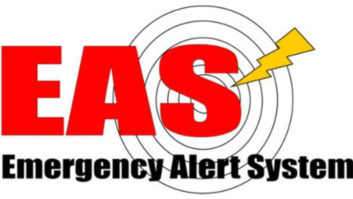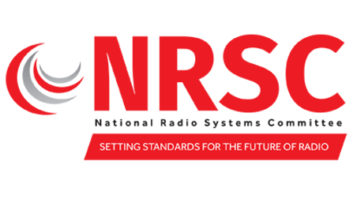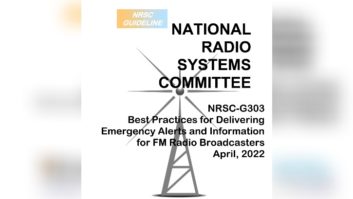
As more comments continue to roll in about the nationwide EAS test on Sept. 27, it’s clear that while the test came through well for many stations, some blips inevitably happened — from simple audio hiss to stations receiving feeds with no audio at all.
“All our stations successfully received and forwarded the national test,” said Cris Alexander, chief engineer with Crawford Broadcasting Co., which has AM and FM stations across seven states.
Yet one interesting note, Alexander said, was that that the Local Primary (LP1 or LP2) relays came through before the CAP message in some cases. “In at least one case we had the double audio issue that we saw last time around,” he said.
There is a real downside to this, he said. “In Portland, for example, the NPT came in to the Washington County OEM, which for some reason forwarded it without audio. The EOM came right after the header, and the total length of the forwarded NPT was only 17 seconds. The LP1 and LP2 then forwarded it the way they received it: no audio. Which arguably makes it worthless. Had the CAP feed come in before the LP feed, there would have been audio,” he said.
While many stations across the state of Washington reported excellent audio quality when the alert was sent out at 2:20 p.m. EDT on Wednesday, others ran into issues.
Chief engineerLowell Kiesow, chief engineer of KNKX(FM) in Tacoma, Wash., and chair of the technical committee of the Washington SECC, said the test went well for many. Twenty-four hours after the test, 43 stations reported audio quality was acceptable, he said, with 27 stations receiving the message from IPAWS, all of which resulted in “very good” audio.
But that there were a few exceptions. One facility with five stations had missing audio due to it being relayed through multiple generations. And 21 stations received the message from analog sources with the typical generational losses in audio quality.
This points to a key problem with the current FCC rules, Kiesow said. “For any alert that is duplicated by both a CAP source, such as IPAWS, and by analog distribution systems, the CAP message should be given priority to be the source that gets aired,” he said. “Right now, whichever source arrives first is the one that gets aired. Giving CAP priority, would ensure the best audio quality is broadcast, with no generational losses.”
In a setup that is unique to Washington, the National Weather Service relayed the NPT successfully over seven transmitters from the Seattle office. “It may be the only NWS facility equipped to relay civil alerts,” he said. “A project to develop that capability across the country is several years behind schedule.”
He also said that at least one station, KDDS(FM) in Elma, Wash., had their Sage ENDEC configured to relay the test in Spanish. It didn’t work, Kiesow said, because they received the test from an analog source first.
“Again, a poor outcome from the problem I spoke of, about not having CAP priority. Both FEMA and the FCC have made a big deal about multilingual messages, but their own rules are preventing it from happening.”
In Southern California, there were reports of “poor-quality AM radio garble” by KBUU(FM) after the signal was relayed by KFI, the PEP station for Southern California. According to Hans Laetz, licensee of KBUU(FM) in Malibu, the FEMA test delivery system resulted in a static-filled AM radio message from a transmitter 55 miles away that interrupted our FM stereo signal and needlessly alarmed listeners here,” he said.
“Listeners commented on our social media page that the EAS test was ‘scary’ and ‘awful.’ One said that it made her start to rush to their kid’s school [out of fear that] North Korea had launched missiles.”
“Please, please, please, Oh, FCC gods, make it possible for EAS receivers to wait a few seconds to get a clean CAP rather than staticky AM signal,” he said. “The idea is to convey information. Waiting a few seconds for a clean feed is preferable to ordering us to transmit garble.”
“I would like to know what purpose is fulfilled by alarming my listeners broadcasting a barely-intelligible message on static-filled AM radio, when the same test could have been performed 90 seconds later using a clean computer message,” he said, stressing that his station is committed to using EAS when appropriate. “Why is an announcement even necessary? Why not just ‘EAS test. 1, 2, 3, test over,’?”
Up north in San Francisco at KPOO(FM), part-time engineer and on-air personality Dave Billeci reported less than stellar audio reception. “The noise level was very high during the voice message segment. The white noise level made the voice announcement difficult to hear.”
However, listener Keith Frick heard the test on KUSC(FM) relayed via KDB(FM) in Santa Barbara, and he found “every word was intelligible. The message came through. There were no digital artifacts, buffering or drop outs.”
Across the country in Alabama, early results were very positive. “[Alabama] was very successful in receiving and relaying the National EAS Test,” said Larry Wilkins with the Alabama Broadcasters Association. “Our FTP server monitors 105 different EAS systems across the state and it reported 100% successful operations.”
About 60% received directly from the IPAWS server, the remainder from RF sources, Wilkins said
Likewise, the tests went smoothly for a number of stations in Las Vegas. “My eight radio stations and an additional Sage unit on an HD2 [had] no issues with receiving or retransmitting,” said Bill Croghan, chief engineer with Lotus Broadcasting. “Some stations retransmitted the PEP relay; most were able to send the IPAWS alert.”
Part of that was due to the setup the Nevada SECC did last month running an RMT as an NPT with only NV addressed, he said. “If we received it then, it was going to go well today,” he said. “[It] gave us a month to resolve problems; fortunately I had none either time.”
In Cleveland, the test “went perfect” for all four Radio One stations, said Gary Zocolo, chief engineer and IT manager for Radio One Cleveland. The stations relayed “very good” audio from LP1 WTAM(AM) 1100 kHz, he said.
When it comes to assessment about relays, Zocolo reported that for his stations, the CAP versus LPX relay is a function of the polling interval of the IPAWS server.
“If the alert occurs one second after your EAS unit last polled the IPAWS server, with a 60-second default polling interval, your hardware will not get the CAP version for another 59 seconds when it polls again,” he said.
That is more than enough time for the LP1s and LP2s to beat the CAP audio to your decoder, he said. “As it stands now it is a pretty much random luck of the draw as to when your unit polls and when the alert hits CAP, LP1 and 2.” Zocolo said his CAP message arrived 55 seconds after I got the LP1 message at 14:20:55.
There was also a report of a few stations being impacted by IT security firewalls that blocked download of the external audio resource. If an operation has an IT enterprise locked down, in some cases the audio file was blocked by IT firewall policies.
Some members of the listening public had a few ideas for FEMA to improvement process.
While listening to KKGO(FM) in Los Angeles, listener Chime Hart said that the audio was clear, but thought that the individual doing the actual EAS announcing “was quite drab.” Hart also thought the alert should have taken the opportunity to mention the reasons that such a national alert would be sent out.
“I really think an announcement should have read, ‘If this had been an actual national emergency, such as a nuclear attack or an asteroid, an attention signal would have been followed by official information,’” Hart said. “My concern was there were hardly any mentions of this as national in scope.”
There were similar reports of clear audio reception in Florida, Kentucky and North Carolina as well.
There are also ongoing questions about whether stations in Puerto Rico received or sent any EAS tests, since many have been hit hard by Hurricane Maria.












